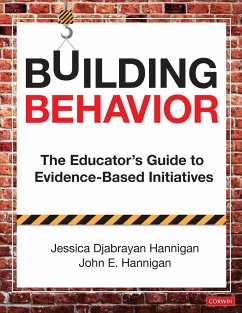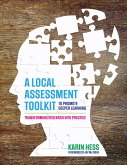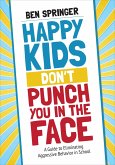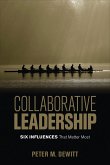Jessica Djabrayan Hannigan, John E. Hannigan
Building Behavior
The Educator′s Guide to Evidence-Based Initiatives
29,99 €
inkl. MwSt.
Versandfertig in 2-4 Wochen

15 °P sammeln
Jessica Djabrayan Hannigan, John E. Hannigan
Building Behavior
The Educator′s Guide to Evidence-Based Initiatives
- Broschiertes Buch
- Merkliste
- Auf die Merkliste
- Bewerten Bewerten
- Teilen
- Produkt teilen
- Produkterinnerung
- Produkterinnerung
School leaders can use this practical guide to implement the most effective behavior practices, programs, and initiatives their school needs in a systematic and sustainable way.
Andere Kunden interessierten sich auch für
![A Local Assessment Toolkit to Promote Deeper Learning A Local Assessment Toolkit to Promote Deeper Learning]() Karin J. HessA Local Assessment Toolkit to Promote Deeper Learning53,99 €
Karin J. HessA Local Assessment Toolkit to Promote Deeper Learning53,99 €![Happy Kids Don′t Punch You in the Face Happy Kids Don′t Punch You in the Face]() Ben SpringerHappy Kids Don′t Punch You in the Face26,99 €
Ben SpringerHappy Kids Don′t Punch You in the Face26,99 €![Student Voice Student Voice]() Russell J. QuagliaStudent Voice46,99 €
Russell J. QuagliaStudent Voice46,99 €![Collaborative Leadership Collaborative Leadership]() Peter M. DeWittCollaborative Leadership30,99 €
Peter M. DeWittCollaborative Leadership30,99 €![Good to Great to Innovate Good to Great to Innovate]() Lyn D. SharrattGood to Great to Innovate40,99 €
Lyn D. SharrattGood to Great to Innovate40,99 €![What Does Your School Data Team Sound Like? What Does Your School Data Team Sound Like?]() Dean T. SpauldingWhat Does Your School Data Team Sound Like?47,99 €
Dean T. SpauldingWhat Does Your School Data Team Sound Like?47,99 €![Reach for Greatness Reach for Greatness]() Yong ZhaoReach for Greatness31,99 €
Yong ZhaoReach for Greatness31,99 €-
-
-
School leaders can use this practical guide to implement the most effective behavior practices, programs, and initiatives their school needs in a systematic and sustainable way.
Hinweis: Dieser Artikel kann nur an eine deutsche Lieferadresse ausgeliefert werden.
Hinweis: Dieser Artikel kann nur an eine deutsche Lieferadresse ausgeliefert werden.
Produktdetails
- Produktdetails
- Verlag: SAGE Publications Inc
- Seitenzahl: 184
- Erscheinungstermin: 9. Juli 2019
- Englisch
- Abmessung: 277mm x 213mm x 15mm
- Gewicht: 494g
- ISBN-13: 9781544340081
- ISBN-10: 1544340087
- Artikelnr.: 55497109
- Herstellerkennzeichnung
- Libri GmbH
- Europaallee 1
- 36244 Bad Hersfeld
- gpsr@libri.de
- Verlag: SAGE Publications Inc
- Seitenzahl: 184
- Erscheinungstermin: 9. Juli 2019
- Englisch
- Abmessung: 277mm x 213mm x 15mm
- Gewicht: 494g
- ISBN-13: 9781544340081
- ISBN-10: 1544340087
- Artikelnr.: 55497109
- Herstellerkennzeichnung
- Libri GmbH
- Europaallee 1
- 36244 Bad Hersfeld
- gpsr@libri.de
Dr. Jessica Djabrayan Hannigan is an Assistant Professor in the Educational Leadership Department at California State University, Fresno. She works with schools and districts throughout the nation on designing and implementing effective behavior systems. Dr. Hannigan has a background in special education and student support services as well as experience with district level administration and higher education research. Jessica has developed inclusive research based best practices around systematic implementation of behavior initiatives. Dr. Hannigan is the co-author of multiple educational books such as The PBIS Tier One Handbook, The PBIS Tier Two Handbook, The PBIS Tier Three Handbook, Don't Suspend Me! An Alternative Discipline Toolkit, Building Behavior, The MTSS Start-Up Guide, and Behavior Solutions. She has received multiple recognitions for her work, including being named California Outstanding School Psychologist of the Year, Administrator of the Year, Outstanding Faculty Publications and Service Award recipient. She was also recognized by the California Legislature Assembly for her work in social justice and equity. In 2017, Dr. Hannigan was awarded the inaugural Association of California School Administrators Exemplary Woman in Education Award for her persistent work around equity in schools.
Acknowledgments About the Authors PART I
BUILDING BEHAVIOR (THE WHY) Chapter 1
Building Effective Behavior Initiatives in Schools The Why Behind This Book How to Use This Book: Building Behavior Behavior Initiatives K-W-L Strategy Before You Begin: An Important Note PART II
BUILDING BEHAVIOR (THE WHAT) Chapter 2
Positive Behavior Interventions and Supports The What-Positive Behavior Interventions and Supports (PBIS) Connection to Hattie's Effect Sizes in Relation to the Core Components of PBIS Synthesized Indicators of PBIS Implementation Success and Challenges PBIS Best-Practice Resource Inventory Chapter 3
Character Education The What-Character Education Connection to Hattie's Effect Sizes in Relation to the Core Components of Character Education Synthesized Indicators of Character Education Implementation Success and Challenges Character Education Best-Practice Resource Inventory Chapter 4
Restorative Justice The What-Restorative Justice Connection to Hattie's Effect Sizes in Relation to the Core Components of Restorative Justice Synthesized Indicators of Restorative Justice Implementation Success and Challenges Restorative Justice Best-Practice Resource Inventory Chapter 5
Culturally Responsive Teaching The What-Culturally Responsive Teaching (CRT) Connection to Hattie's Effect Sizes in Relation to the Core Components of CRT Synthesized Indicators of CRT Implementation Success and Challenges CRT Best-Practice Resource Inventory Chapter 6
Trauma-Informed Practices The What-Trauma-Informed Practices (TIPs) Connection to Hattie's Effect Sizes in Relation to the Core Components of TIPs Synthesized Indicators of TIPs Implementation Success and Challenges TIPs Best-Practice Resource Inventory Chapter 7
Social and Emotional Learning The What-Social and Emotional Learning (SEL) Connection to Hattie's Effect Sizes in Relation to the Core Components of SEL Synthesized Indicators of SEL Implementation Success and Challenges SEL Best-Practice Resource Inventory PART III
BUILDING BEHAVIOR (THE HOW) Chapter 8
Bringing It All Together: Building Behavior Initiatives Bringing It All Together: Synthesis of the Six Behavior Initiatives SchoolWide Behavior Initiatives Process (SW-BIP) SW-BIP Phase 1: Selection SW-BIP Phase 2: Self-Assessment SW-BIP Phase 3: Solutions Closing Thoughts: Tips and Suggestions from the Authors References Index
BUILDING BEHAVIOR (THE WHY) Chapter 1
Building Effective Behavior Initiatives in Schools The Why Behind This Book How to Use This Book: Building Behavior Behavior Initiatives K-W-L Strategy Before You Begin: An Important Note PART II
BUILDING BEHAVIOR (THE WHAT) Chapter 2
Positive Behavior Interventions and Supports The What-Positive Behavior Interventions and Supports (PBIS) Connection to Hattie's Effect Sizes in Relation to the Core Components of PBIS Synthesized Indicators of PBIS Implementation Success and Challenges PBIS Best-Practice Resource Inventory Chapter 3
Character Education The What-Character Education Connection to Hattie's Effect Sizes in Relation to the Core Components of Character Education Synthesized Indicators of Character Education Implementation Success and Challenges Character Education Best-Practice Resource Inventory Chapter 4
Restorative Justice The What-Restorative Justice Connection to Hattie's Effect Sizes in Relation to the Core Components of Restorative Justice Synthesized Indicators of Restorative Justice Implementation Success and Challenges Restorative Justice Best-Practice Resource Inventory Chapter 5
Culturally Responsive Teaching The What-Culturally Responsive Teaching (CRT) Connection to Hattie's Effect Sizes in Relation to the Core Components of CRT Synthesized Indicators of CRT Implementation Success and Challenges CRT Best-Practice Resource Inventory Chapter 6
Trauma-Informed Practices The What-Trauma-Informed Practices (TIPs) Connection to Hattie's Effect Sizes in Relation to the Core Components of TIPs Synthesized Indicators of TIPs Implementation Success and Challenges TIPs Best-Practice Resource Inventory Chapter 7
Social and Emotional Learning The What-Social and Emotional Learning (SEL) Connection to Hattie's Effect Sizes in Relation to the Core Components of SEL Synthesized Indicators of SEL Implementation Success and Challenges SEL Best-Practice Resource Inventory PART III
BUILDING BEHAVIOR (THE HOW) Chapter 8
Bringing It All Together: Building Behavior Initiatives Bringing It All Together: Synthesis of the Six Behavior Initiatives SchoolWide Behavior Initiatives Process (SW-BIP) SW-BIP Phase 1: Selection SW-BIP Phase 2: Self-Assessment SW-BIP Phase 3: Solutions Closing Thoughts: Tips and Suggestions from the Authors References Index
Acknowledgments About the Authors PART I
BUILDING BEHAVIOR (THE WHY) Chapter 1
Building Effective Behavior Initiatives in Schools The Why Behind This Book How to Use This Book: Building Behavior Behavior Initiatives K-W-L Strategy Before You Begin: An Important Note PART II
BUILDING BEHAVIOR (THE WHAT) Chapter 2
Positive Behavior Interventions and Supports The What-Positive Behavior Interventions and Supports (PBIS) Connection to Hattie's Effect Sizes in Relation to the Core Components of PBIS Synthesized Indicators of PBIS Implementation Success and Challenges PBIS Best-Practice Resource Inventory Chapter 3
Character Education The What-Character Education Connection to Hattie's Effect Sizes in Relation to the Core Components of Character Education Synthesized Indicators of Character Education Implementation Success and Challenges Character Education Best-Practice Resource Inventory Chapter 4
Restorative Justice The What-Restorative Justice Connection to Hattie's Effect Sizes in Relation to the Core Components of Restorative Justice Synthesized Indicators of Restorative Justice Implementation Success and Challenges Restorative Justice Best-Practice Resource Inventory Chapter 5
Culturally Responsive Teaching The What-Culturally Responsive Teaching (CRT) Connection to Hattie's Effect Sizes in Relation to the Core Components of CRT Synthesized Indicators of CRT Implementation Success and Challenges CRT Best-Practice Resource Inventory Chapter 6
Trauma-Informed Practices The What-Trauma-Informed Practices (TIPs) Connection to Hattie's Effect Sizes in Relation to the Core Components of TIPs Synthesized Indicators of TIPs Implementation Success and Challenges TIPs Best-Practice Resource Inventory Chapter 7
Social and Emotional Learning The What-Social and Emotional Learning (SEL) Connection to Hattie's Effect Sizes in Relation to the Core Components of SEL Synthesized Indicators of SEL Implementation Success and Challenges SEL Best-Practice Resource Inventory PART III
BUILDING BEHAVIOR (THE HOW) Chapter 8
Bringing It All Together: Building Behavior Initiatives Bringing It All Together: Synthesis of the Six Behavior Initiatives SchoolWide Behavior Initiatives Process (SW-BIP) SW-BIP Phase 1: Selection SW-BIP Phase 2: Self-Assessment SW-BIP Phase 3: Solutions Closing Thoughts: Tips and Suggestions from the Authors References Index
BUILDING BEHAVIOR (THE WHY) Chapter 1
Building Effective Behavior Initiatives in Schools The Why Behind This Book How to Use This Book: Building Behavior Behavior Initiatives K-W-L Strategy Before You Begin: An Important Note PART II
BUILDING BEHAVIOR (THE WHAT) Chapter 2
Positive Behavior Interventions and Supports The What-Positive Behavior Interventions and Supports (PBIS) Connection to Hattie's Effect Sizes in Relation to the Core Components of PBIS Synthesized Indicators of PBIS Implementation Success and Challenges PBIS Best-Practice Resource Inventory Chapter 3
Character Education The What-Character Education Connection to Hattie's Effect Sizes in Relation to the Core Components of Character Education Synthesized Indicators of Character Education Implementation Success and Challenges Character Education Best-Practice Resource Inventory Chapter 4
Restorative Justice The What-Restorative Justice Connection to Hattie's Effect Sizes in Relation to the Core Components of Restorative Justice Synthesized Indicators of Restorative Justice Implementation Success and Challenges Restorative Justice Best-Practice Resource Inventory Chapter 5
Culturally Responsive Teaching The What-Culturally Responsive Teaching (CRT) Connection to Hattie's Effect Sizes in Relation to the Core Components of CRT Synthesized Indicators of CRT Implementation Success and Challenges CRT Best-Practice Resource Inventory Chapter 6
Trauma-Informed Practices The What-Trauma-Informed Practices (TIPs) Connection to Hattie's Effect Sizes in Relation to the Core Components of TIPs Synthesized Indicators of TIPs Implementation Success and Challenges TIPs Best-Practice Resource Inventory Chapter 7
Social and Emotional Learning The What-Social and Emotional Learning (SEL) Connection to Hattie's Effect Sizes in Relation to the Core Components of SEL Synthesized Indicators of SEL Implementation Success and Challenges SEL Best-Practice Resource Inventory PART III
BUILDING BEHAVIOR (THE HOW) Chapter 8
Bringing It All Together: Building Behavior Initiatives Bringing It All Together: Synthesis of the Six Behavior Initiatives SchoolWide Behavior Initiatives Process (SW-BIP) SW-BIP Phase 1: Selection SW-BIP Phase 2: Self-Assessment SW-BIP Phase 3: Solutions Closing Thoughts: Tips and Suggestions from the Authors References Index







